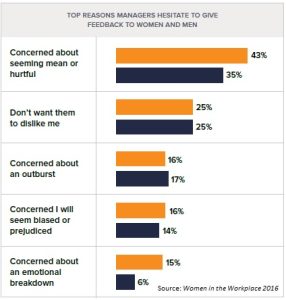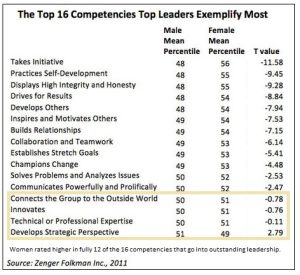This is first of two parts on gender diversity in leadership positions. Today’s article discusses the current lack of women leaders, the reasons why, as well as describing the benefits women leaders bring to an organization. Part two, offering solutions, will post tomorrow.
————
The most recent allegations of sexual harassment by management and subsequent apathy by HR at hot tech startup Uber have once again brought to the fore the lack of progress we’ve made in gender equality. What Susan Fowler’s story highlights is that not only do women face direct discrimination from managers and peers, when they speak out they often feel the backlash in their opportunities for advancement.
The lack of female leaders in general, and especially in the tech world, is one of the most highly discussed challenges. All the industry giants have been criticized for continuing to have such low numbers of women on the board, in management positions or even in the workforce in general. This has caused many, such as Facebook, Google and Apple to publicly release reports on their diversity statistics and commit to developing more female leaders. The numbers of women of color in leadership positions is even lower. A study by the AAUW found that out of Standard & Poor’s 500 only 4% of executive officials and managers were women of color.
Bottom line impacts
Not only is this an issue about equality, it also greatly impacts a company’s bottom line. Studies show that companies which are more gender diverse are 15% more likely to outperform and those which are more ethnically diverse are 35% more likely to outperform. Companies with more female leaders are also proven to be more profitable. In fact, studies have shown that women are typically rated as being more effective leaders overall than men by their reports, peers and managers. So why are there so few female leaders?
How bias works in the workplace
Even if your company has a clear policy against inequality in promotions and pay, why does it still happen? To find out you have to look at the root causes.
Similarity bias: Similarity bias is the tendency for people to want to help and mentor people who remind them of themselves when they were coming up in the company. As the majority of managers are still men, it’s not uncommon for them to see themselves in a male report who may have the same personality and interests as them when they began working. Even if unconscious, this can lead managers to favor certain reports with extra mentoring and, thereby, opportunities for development.
In feedback: Feedback and performance reviews are essential to helping employees develop professionally and for companies to identify top performers for new positions. When unconscious bias finds its way into these important tools for advancement, it can cause women to be held back under the radar.
 A joint 2016 study by McKinsey & Company and LeanIn.org found that, while both genders ask for feedback equally, women are 20% less likely to receive difficult feedback. The most common answer given is that managers don’t want to seem “mean” or “hurtful.” Most managers already find it difficult to give constructive feedback, even when their employees ask for it. If male managers hold on to an unconscious fear that women will be more likely to react emotionally to feedback, their female reports will not receive the same coaching opportunities as their male peers.
A joint 2016 study by McKinsey & Company and LeanIn.org found that, while both genders ask for feedback equally, women are 20% less likely to receive difficult feedback. The most common answer given is that managers don’t want to seem “mean” or “hurtful.” Most managers already find it difficult to give constructive feedback, even when their employees ask for it. If male managers hold on to an unconscious fear that women will be more likely to react emotionally to feedback, their female reports will not receive the same coaching opportunities as their male peers.
Adding another layer, a study by the Center for Talent Innovation found that ⅔ of men in senior positions pulled back from 1-on-1 contact with junior female employees for fear that they might be suspected of having an affair.
What’s more, when women do receive feedback, studies show it is often vague and not tied to business outcomes. This means that, whether it’s positive or constructive, women are less likely to be told what specific actions contributed to the team/company objectives or how they can improve. Meanwhile, their male colleagues are more likely to receive a clear picture of how they’re doing and what they can do to improve.
People also have a tendency to see certain behaviors as primarily male or female. For example, assertiveness, independence and authority are often stereotyped as “male,” while supportive, collaborative and helpful are perceived as typically “female.” Therefore, studies show that when women demonstrate qualities typically associated with men, it is often criticized. For example, two studies cited in The Wall Street Journal in particular have shown that while men are often described as “confident and assertive,” for the same behavior, women are described as “abrasive and off-putting. “
Are men more effective leaders?
 However, a study by Zenger and Folkman sought to evaluate the effectiveness of male versus female leaders in 16 leadership qualities. Overall women were perceived as more effective and surpassed men in 12 categories, even those typically perceived as “male” such as taking initiative and driving for results.
However, a study by Zenger and Folkman sought to evaluate the effectiveness of male versus female leaders in 16 leadership qualities. Overall women were perceived as more effective and surpassed men in 12 categories, even those typically perceived as “male” such as taking initiative and driving for results.
Perhaps most convincing of all, a meta-analysis of 99 data sets from 95 studies conducted between 1962-2011 published in the Journal of Applied Psychology, similarly found that female leaders were rated by their reports, peers and managers as being just as or even more effective than male leaders.
The interesting question is why women continue to be overlooked for leadership positions? These studies may reveal some answers. For one, the meta-analysis showed that, while they’re rated highly by others, many have a tendency to underrate themselves in their self-assessments. Another, as mentioned previously, is the tendency to perceive the desired leadership skills as those regularly stereotyped as “male”.
Stereotyping women leaders
The problem is not just how men and women are being stereotyped but also how roles are being stereotyped. The qualities most often looked for in a leader, such as assertiveness, authority and taking initiative are also those typically misidentified as typically “male traits.”
These traits represent an outdated perception we have of the typical authoritarian manager who oversees, pushes for results and relays information from the executive level. Continuing to rely on this standard view of the typical manager is not only blocking women from being chosen for leadership positions, but also harming many organizations. A study by Gallup found that companies chose the wrong person for management positions 82% of the time.
In today’s flattening, collaborative, autonomous work atmosphere companies are beginning to realize they want coaches, not managers. Some of the top qualities needed are instead: emotional intelligence, coaching/mentoring, ability to motivate and engage through purpose, empowering through autonomy and ownership. In effect, not only are our perceptions of female vs male leaders incorrect, our perceptions of what makes a great leader are also based on outdated stereotypes.
Part two of this article will post tomorrow. It lists 6 steps your company can take to develop female leaders and increase the number of women in management positions.
